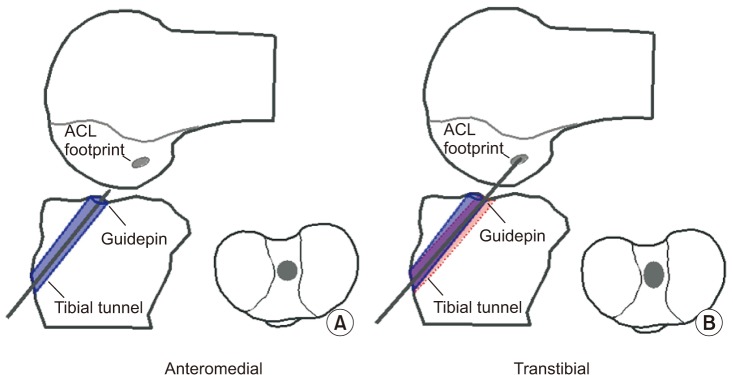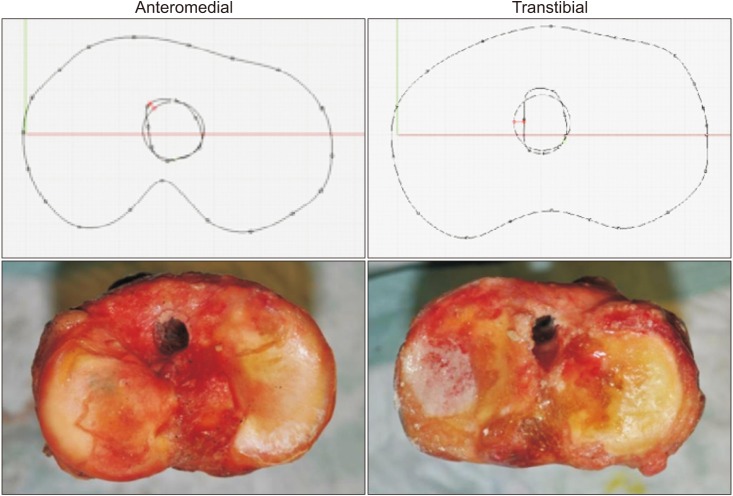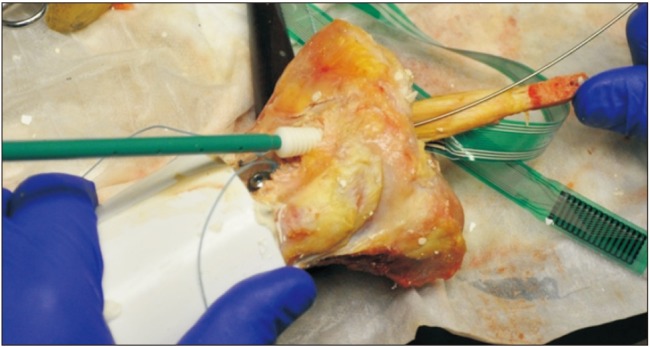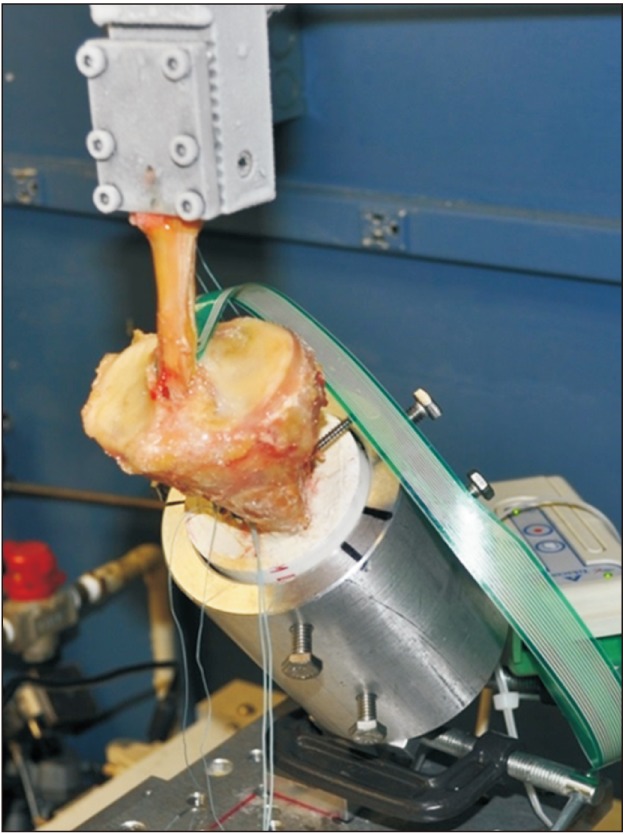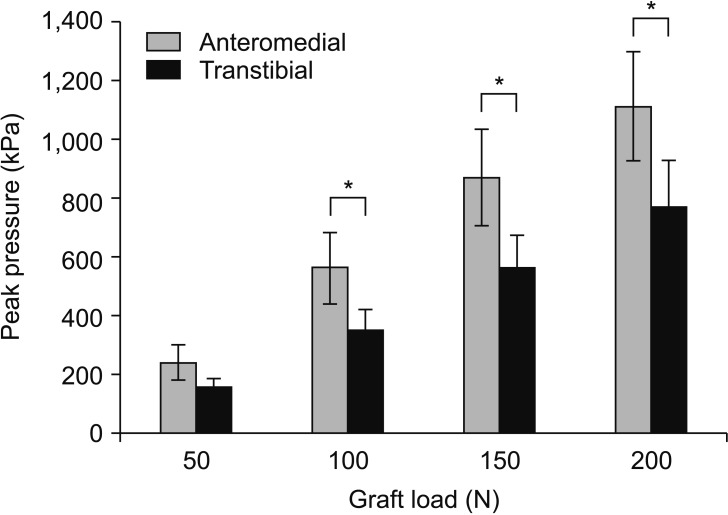Clin Orthop Surg.
2019 Mar;11(1):52-59. 10.4055/cios.2019.11.1.52.
Effects of Anteromedial Portal versus Transtibial ACL Tunnel Preparation on Contact Characteristics of the Graft and the Tibial Tunnel Aperture
- Affiliations
-
- 1Orthopaedic Biomechanics Laboratory, Congress Medical Foundation, Pasadena, CA, USA. cagjamd@aol.com
- 2Orthopaedic Biomechanics Laboratory, Tibor Rubin VA Medical Center, Long Beach, CA, USA.
- 3Department of Orthopaedic Surgery, University of California Irvine, Orange, CA, USA.
- KMID: 2438334
- DOI: http://doi.org/10.4055/cios.2019.11.1.52
Abstract
- BACKGROUND
The purpose of this study was to compare the tibial tunnel aperture contact characteristics simulating an anteromedial and transtibial anterior cruciate ligament (ACL) tunnel preparation.
METHODS
Seven matched pairs of cadaveric knees were tested. From each knee, a 10-mm quadriceps ACL graft was prepared. The native ACL was arthroscopically removed and tibial tunnels were drilled. In one knee, a transtibial technique was performed with femoral tunnel drilling approached through the tibial tunnel. For the anteromedial technique on the contralateral knee, the posterior tibial tunnel was chamfered with a rasp. The knees were then disarticulated and tibial tunnel aperture geometry was measured. A pressure sensor was placed between the graft and the posterior aspect of the tibial tunnel and the graft was secured with an interference screw. Contact force, contact area, contact pressure, peak contact pressure, hysteresis and stiffness were measured at cyclic loads of 50 N, 100 N, 150 N, and 200 N.
RESULTS
Tibial tunnel aperture area, diameter and deviation from a circle were significantly larger with the transtibial technique (p < 0.05). There was no significant difference in hysteresis, stiffness, contact area, contact force and mean contact pressure. The peak contact pressure between the ACL graft and the tibial tunnel was significantly higher with the anteromedial technique for 100 N (p = 0.04), 150 N (p = 0.01), and 200 N (p = 0.002) cyclic loading.
CONCLUSIONS
Increased peak contact pressure on the graft at the tibial aperture with the anteromedial technique may increase the stress on the graft and possibly lead to failure following ACL reconstruction.
Keyword
MeSH Terms
Figure
Reference
-
1. Lee MC, Seong SC, Lee S, et al. Vertical femoral tunnel placement results in rotational knee laxity after anterior cruciate ligament reconstruction. Arthroscopy. 2007; 23(7):771–778. PMID: 17637414.
Article2. Pearle AD, Shannon FJ, Granchi C, Wickiewicz TL, Warren RF. Comparison of 3-dimensional obliquity and anisometric characteristics of anterior cruciate ligament graft positions using surgical navigation. Am J Sports Med. 2008; 36(8):1534–1541. PMID: 18390491.
Article3. Gadikota HR, Sim JA, Hosseini A, Gill TJ, Li G. The relationship between femoral tunnels created by the transtibial, anteromedial portal, and outside-in techniques and the anterior cruciate ligament footprint. Am J Sports Med. 2012; 40(4):882–888. PMID: 22302206.
Article4. Bedi A, Musahl V, Steuber V, et al. Transtibial versus anteromedial portal reaming in anterior cruciate ligament reconstruction: an anatomic and biomechanical evaluation of surgical technique. Arthroscopy. 2011; 27(3):380–390. PMID: 21035990.
Article5. Maletis GB, Cameron SL, Tengan JJ, Burchette RJ. A prospective randomized study of anterior cruciate ligament reconstruction: a comparison of patellar tendon and quadruple-strand semitendinosus/gracilis tendons fixed with bioabsorbable interference screws. Am J Sports Med. 2007; 35(3):384–394. PMID: 17218661.6. Buchner M, Schmeer T, Schmitt H. Anterior cruciate ligament reconstruction with quadrupled semitendinosus tendon: minimum 6 year clinical and radiological follow-up. Knee. 2007; 14(4):321–327. PMID: 17512735.7. Strauss EJ, Barker JU, McGill K, Cole BJ, Bach BR Jr, Verma NN. Can anatomic femoral tunnel placement be achieved using a transtibial technique for hamstring anterior cruciate ligament reconstruction? Am J Sports Med. 2011; 39(6):1263–1269. PMID: 21335354.
Article8. Giron F, Cuomo P, Edwards A, Bull AM, Amis AA, Aglietti P. Double-bundle “anatomic” anterior cruciate ligament reconstruction: a cadaveric study of tunnel positioning with a transtibial technique. Arthroscopy. 2007; 23(1):7–13. PMID: 17210421.
Article9. Rue JP, Ghodadra N, Lewis PB, Bach BR Jr. Femoral and tibial tunnel position using a transtibial drilled anterior cruciate ligament reconstruction technique. J Knee Surg. 2008; 21(3):246–249. PMID: 18686488.
Article10. Steiner ME, Battaglia TC, Heming JF, Rand JD, Festa A, Baria M. Independent drilling outperforms conventional transtibial drilling in anterior cruciate ligament reconstruction. Am J Sports Med. 2009; 37(10):1912–1919. PMID: 19729364.
Article11. Bedi A, Raphael B, Maderazo A, Pavlov H, Williams RJ 3rd. Transtibial versus anteromedial portal drilling for anterior cruciate ligament reconstruction: a cadaveric study of femoral tunnel length and obliquity. Arthroscopy. 2010; 26(3):342–350. PMID: 20206044.
Article12. Franceschi F, Papalia R, Rizzello G, Del Buono A, Maffulli N, Denaro V. Anteromedial portal versus transtibial drilling techniques in anterior cruciate ligament reconstruction: any clinical relevance? A retrospective comparative study. Arthroscopy. 2013; 29(8):1330–1337. PMID: 23906273.
Article13. Silva A, Sampaio R, Pinto E. ACL reconstruction: comparison between transtibial and anteromedial portal techniques. Knee Surg Sports Traumatol Arthrosc. 2012; 20(5):896–903. PMID: 21850428.
Article14. Keller TC, Tompkins M, Economopoulos K, et al. Tibial tunnel placement accuracy during anterior cruciate ligament reconstruction: independent femoral versus transtibial femoral tunnel drilling techniques. Arthroscopy. 2014; 30(9):1116–1123. PMID: 24907026.
Article15. Wang H, Fleischli JE, Zheng NN. Transtibial versus anteromedial portal technique in single-bundle anterior cruciate ligament reconstruction: outcomes of knee joint kinematics during walking. Am J Sports Med. 2013; 41(8):1847–1856. PMID: 23752955.16. Youm YS, Cho SD, Lee SH, Youn CH. Modified transtibial versus anteromedial portal technique in anatomic single-bundle anterior cruciate ligament reconstruction: comparison of femoral tunnel position and clinical results. Am J Sports Med. 2014; 42(12):2941–2947. PMID: 25269655.17. Koutras G, Papadopoulos P, Terzidis IP, Gigis I, Pappas E. Short-term functional and clinical outcomes after ACL reconstruction with hamstrings autograft: transtibial versus anteromedial portal technique. Knee Surg Sports Traumatol Arthrosc. 2013; 21(8):1904–1909. PMID: 23203338.
Article18. Duffee A, Magnussen RA, Pedroza AD, Flanigan DC, Kaeding CC. MOON Group. Transtibial ACL femoral tunnel preparation increases odds of repeat ipsilateral knee surgery. J Bone Joint Surg Am. 2013; 95(22):2035–2042. PMID: 24257662.
Article19. Rahr-Wagner L, Thillemann TM, Pedersen AB, Lind MC. Increased risk of revision after anteromedial compared with transtibial drilling of the femoral tunnel during primary anterior cruciate ligament reconstruction: results from the Danish Knee Ligament Reconstruction Register. Arthroscopy. 2013; 29(1):98–105. PMID: 23276417.
Article20. Graf BK, Henry J, Rothenberg M, Vanderby R. Anterior cruciate ligament reconstruction with patellar tendon: an ex vivo study of wear-related damage and failure at the femoral tunnel. Am J Sports Med. 1994; 22(1):131–135. PMID: 8129096.21. Toritsuka Y, Shino K, Horibe S, et al. Second-look arthroscopy of anterior cruciate ligament grafts with multistranded hamstring tendons. Arthroscopy. 2004; 20(3):287–293. PMID: 15007317.
Article22. Nishimoto K, Kuroda R, Mizuno K, et al. Analysis of the graft bending angle at the femoral tunnel aperture in anatomic double bundle anterior cruciate ligament reconstruction: a comparison of the transtibial and the far anteromedial portal technique. Knee Surg Sports Traumatol Arthrosc. 2009; 17(3):270–276. PMID: 19048229.
Article23. Wang JH, Kim JG, Lee DK, Lim HC, Ahn JH. Comparison of femoral graft bending angle and tunnel length between transtibial technique and transportal technique in anterior cruciate ligament reconstruction. Knee Surg Sports Traumatol Arthrosc. 2012; 20(8):1584–1593. PMID: 22120838.
Article24. Shin YS, Ro KH, Jeon JH, Lee DH. Graft-bending angle and femoral tunnel length after single-bundle anterior cruciate ligament reconstruction: comparison of the transtibial, anteromedial portal and outside-in techniques. Bone Joint J. 2014; 96-B(6):743–751. PMID: 24891573.25. Miller MD, Gerdeman AC, Miller CD, et al. The effects of extra-articular starting point and transtibial femoral drilling on the intra-articular aperture of the tibial tunnel in ACL reconstruction. Am J Sports Med. 2010; 38(4):707–712. PMID: 20164306.
Article26. Denti M, Bigoni M, Randelli P, et al. Graft-tunnel mismatch in endoscopic anterior cruciate ligament reconstruction: intraoperative and cadaver measurement of the intra-articular graft length and the length of the patellar tendon. Knee Surg Sports Traumatol Arthrosc. 1998; 6(3):165–168. PMID: 9704323.27. Chen CH, Chen WJ, Shih CH. Arthroscopic anterior cruciate ligament reconstruction with quadriceps tendon-patellar bone autograft. J Trauma. 1999; 46(4):678–682. PMID: 10217233.
Article28. Illingworth KD, Hensler D, Working ZM, Macalena JA, Tashman S, Fu FH. A simple evaluation of anterior cruciate ligament femoral tunnel position: the inclination angle and femoral tunnel angle. Am J Sports Med. 2011; 39(12):2611–2618. PMID: 21908719.29. Ahn JH, Lee SH, Yoo JC, Ha HC. Measurement of the graft angles for the anterior cruciate ligament reconstruction with transtibial technique using postoperative magnetic resonance imaging in comparative study. Knee Surg Sports Traumatol Arthrosc. 2007; 15(11):1293–1300. PMID: 17721777.
Article30. Caborn DN, Urban WP Jr, Johnson DL, Nyland J, Pienkowski D. Biomechanical comparison between BioScrew and titanium alloy interference screws for bone-patellar tendon-bone graft fixation in anterior cruciate ligament reconstruction. Arthroscopy. 1997; 13(2):229–232. PMID: 9127082.
Article31. Sakane M, Fox RJ, Woo SL, Livesay GA, Li G, Fu FH. In situ forces in the anterior cruciate ligament and its bundles in response to anterior tibial loads. J Orthop Res. 1997; 15(2):285–293. PMID: 9167633.
Article32. Bae JY, Kim GH, Seon JK, Jeon I. Finite element study on the anatomic transtibial technique for single-bundle anterior cruciate ligament reconstruction. Med Biol Eng Comput. 2016; 54(5):811–820. PMID: 26296801.
Article
- Full Text Links
- Actions
-
Cited
- CITED
-
- Close
- Share
- Similar articles
-
- Modified ACL Reconstruction Technique: Femoral Tunnel Preparation through the Anteromedial Portal
- Three-Dimensional Reconstruction Computed Tomography Evaluation of Tunnel Location during Single-Bundle Anterior Cruciate Ligament Reconstruction: A Comparison of Transtibial and 2-Incision Tibial Tunnel-Independent Techniques
- The Effect of Different Sagittal Angles of the Tibial Guide on Aperture Widening of the Tibial Tunnel during Modified Transtibial Anterior Cruciate Ligament Reconstruction: A Randomized In Vivo Study
- Anatomic Single Bundle Anterior Cruciate Ligament Reconstruction by Low Accessory Anteromedial Portal Technique: An In Vivo 3D CT Study
- Femoral Tunnel Drilling Techniques in Anterior Cruciate Ligament Reconstruction

